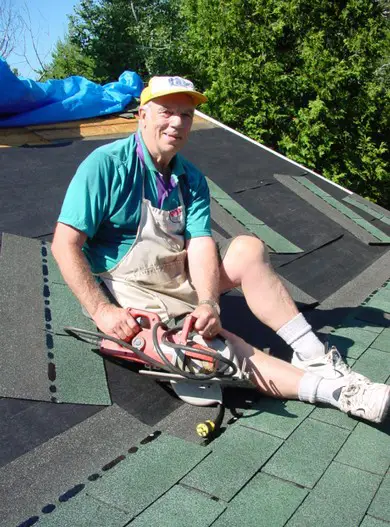A couple of years ago my neighbour Norm needed help. The asphalt roof on his summer place just down the road from where I live was damaged by a storm and needed replacement right away. Some roof boards were rotten too, and he hadn’t brought his jigsaw up with him from the city. Could I lend him a saw to rebuild the roof?
 I didn’t know at the time, but the last tool in the world that Norm wanted to use was a hand-held circular saw. He was 72 years old, and circ saws have always been one power tool that scared him. But that was the tool I unknowingly handed the gentleman, and he took it politely — a lightweight, quiet little cordless model. Five days later, he was a confident sawer with a weatherproof roof. Norm has even graduated to using my great big worm-drive circular saw. It has a power cord as thick as your thumb and he loves it.
I didn’t know at the time, but the last tool in the world that Norm wanted to use was a hand-held circular saw. He was 72 years old, and circ saws have always been one power tool that scared him. But that was the tool I unknowingly handed the gentleman, and he took it politely — a lightweight, quiet little cordless model. Five days later, he was a confident sawer with a weatherproof roof. Norm has even graduated to using my great big worm-drive circular saw. It has a power cord as thick as your thumb and he loves it.
The lesson here is that experience leads to confidence, and confidence leads to success. Hand-held circular saws open a wide range of home improvement possibilities. That’s why they’re a workhorse tool in the trade. The trick is to come to the right decision about tool choice as a homeowner. I believe that one of the reasons hand-held circular saws aren’t well liked in do-it-yourself circles is that so many homeowners choose cheap, trouble-prone saws. If you think you need a circular saw, you need a good one. And this means more than just an economy model.
The big advance in circular saw technology is the emergence of truly useful cordless technology. It was the lightweight and quiet performance of my cordless that got Norm interested in the first place. When this type of tool was introduced back in the mid-1990s, they were cute but weak — definitely not big performers. But now, thanks to advances in batteries, chargers and DC motors, you can finish a basement at full speed with the best and largest cordless circular saws. They’re not as powerful as corded models, but they still do all the same work.
The real question is whether or not you need cordless. They’re convenient and user-friendly, but you do pay a premium for these. An 18-volt to 24-volt cordless circular saw, for instance, typically costs $350 to $450, plus the price of a new battery every three to five years. And I don’t recommend you buy a cordless saw with a lower voltage rating than this range. You might as well use a good handsaw. By comparison, the least expensive contractor-grade plug-in saws start at about $180 and deliver more power than even the largest cordless model.
A worthwhile circular saw will last for years and generate enough power to meet all building challenges. Good plug-in models draw 12 to 15 amps of electricity (look at the motor nameplate you’ll find on every tool for these specs). They also spin a 7 1/4-inch diameter blade — that’s the industry standard. Some models also offer a blade location on either the left side of the machine (for right hand users) or the right side (for left hand users).
You’ll find 18-volt circular saws are good supplemental tools, but you’ll need a 24 volt model to completely replace a corded saw. The best of these also take 7 1/4-inch diameter blades, just like plug-in models. When you’re shopping, look for a package that comes with a diagnostic charger that displays information about battery condition and health. The best cordless tools on the market right now are powered by lithium-ion batteries.
Regardless of the saw design you choose, the cost of the tool really is forgotten long after quality continues to be enjoyed. Wear safety glasses and hearing protection when using the saw, take your time with each cut and have someone else hold your workpiece on something solid while you gain skill with your first few cuts. That’s the approach Norm took and now he’s got a strong new roof and a lot more confidence.